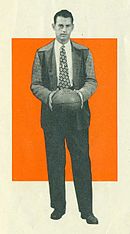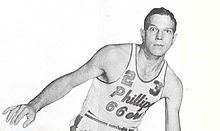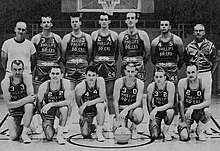Phillips 66ers
| Phillips 66ers | |||
|---|---|---|---|
 | |||
| Nickname | The Oilers | ||
| Leagues | AAU 1921–1968 Missouri Valley 1935–1940 ABL 1945–1948 NIBL 1948–1961 NABL 1966–1968 | ||
| Founded | 1919 | ||
| Folded | 1968 | ||
| Arena | Bartlesville High School Gym (1,400) Phillips Gymnasium (2,600) | ||
| Team colors | Red, White & Black | ||
| Ownership | Phillips | ||
| Championships | 11 AAU tournament 11 National Industrial Basketball League 3 ABL 2 Olympic Trial Playoffs | ||
| |||
The Phillips 66ers (also known as the Oilers) were an amateur basketball team located in Bartlesville, Oklahoma, sponsored and run by the Phillips Petroleum Company. The 66ers were a national phenomenon that grew from a small-town team to an organization of accomplished amateur athletes receiving national and worldwide attention.[citation needed] Under the sponsorship of the company's owner, Frank Phillips, the team, which began playing in 1919, participated in the Amateur Athletic Union (AAU), the nation's premier basketball league before the National Basketball Association. Between 1920 and 1950, some of the strongest basketball teams in the United States were sponsored by corporations: Phillips 66, 20th Century Fox, Safeway Inc., Caterpillar Inc., and others.
The 66ers were a perennial power in AAU basketball in the 1940s, and 1950s. The team won 11 national championships at the AAU national tournament between 1940 and 1963, including six consecutive AAU titles, from 1943 to 1948.[1] In 1948, the 66ers combined with Adolph Rupp's "Fabulous Five" University of Kentucky team to form the U.S. team that won the Olympic basketball tournament.[2]
In almost 50 seasons, the 66ers earned 1543 wins against 271 losses. Twelve 66ers and two coaches represented the United States in Olympic tournaments, and three of them were the only amateur players to have ever played on two Olympic basketball teams. The club ceased operations in 1968.
History
Team creation
Phillips Petroleum was established in 1917, amidst the burgeoning oil industry. In 1919, upon their return from World War I, a group of local individuals in Bartlesville sought employment opportunities at Phillips. Some of them, inspired by their shared experiences, decided to create a basketball team under the Phillips banner. By 1920, this team commenced playing matches against other corporate teams, gradually gaining recognition. In 1921, seeking avenues to maintain fitness during the winter, a contingent of Phillips employees organized a team within the Bartlesville YMCA basketball league.
Initially, their matches were confined to Bartlesville and nearby areas, maintaining a modest profile. However, as time progressed, a spirited rivalry emerged with Empire Oil & Gas.
1921–1942: First years in AAU
The 66ers joined the Amateur Athletic Union, which featured the best basketball players at that time; in 1921.
In the 1920s, the standout player for the team was Paul Endacott, a former college star at Kansas who earned recognition as the Amateur Athletic Union Player of the Year in 1923, a time when there was no NCAA tournament. Joining the 66ers in 1927 as a Phillips employee, Endacott brought his talents to the team. Concurrently, a rivalry with Phillips University of Enid, the national collegiate runner-up, began to intensify.
During the 1928–29 season, Phillips 66 did not field a team. However, the subsequent season marked a pivotal moment coinciding with the company's initiation of marketing its products to the public. This prompted Phillips' leadership to make significant investments in their basketball team. In 1929, Lou Wilkie, the coach of Phillips University of Enid, was hired as the team's first full-time coach. Additionally, several skilled players, many of whom hailed from the disbanded Mid-Continent Oil Co. team, were recruited to bolster the roster.

The 1929–30 team lost in the second round of the national AAU tournament, as did the next year's version. Then, with the Depression raging, Phillips dropped basketball to concentrate on survival. That strategy worked, and by 1936, Phillips was more convinced than ever that a strong basketball team would be good for business.
The AAU's annual tournament drew the best players in the world, as well as thousands of fans and dozens of sports writers and broadcasters. During the 1930s, the only professional basketball teams were barnstormers like the House of David and the Harlem Globetrotters. In all those years the 66ers played against teams fielded by various commercial companies, under the sanction of the Amateur Athletic Union.
Paul Endacott and promising talent David Perkins emerged as pivotal figures during the 1930s for the team. Phillips gradually gained recognition, securing second place in the AAU tournament in both the 1936–37 and 1938–39 seasons, boasting an impressive 36–11 record. Notably, three of those 11 losses were inflicted by the Oklahoma City Parks. Following the disbandment of the Parks after the season, Phillips recruited their top two players, Grady Lewis and Bill Martin, both of whom had earned AAU All-America honors.
G. Harold "Smitty" Schmidt took over coaching duties for 2–4 years towards the end of the 1930s, bringing with him experience as a player under Phog Allen at the University of Kansas. With Lewis, Martin, and talents like Joe Fortenberry and Don Lockard on the roster, the 66ers dominated with a 48–5 record. Their pinnacle moment came with a thrilling 39–36 victory over the reigning champions, the Denver Nuggets, in the finals of the 1939–1940 AAU tournament. The team received an enthusiastic welcome upon their return to the Bartlesville station, celebrated as champions.
Although the team secured second place in the 1940–1941 season, they faced a setback in a post-season Red Cross benefit game in Tulsa, where they lost to Arkansas, led by the towering 6–8 center John Freiberger, who would later join the 66ers. However, the outbreak of World War II and the involvement of the United States led to most of the top players from the 66ers enlisting in the military. Bill Martin joined the Army Air Corps in 1942, followed by John Freiberger in 1943, resulting in a decline in the team's performance during the 1941–1942 season.
1943–1946: Beginning of the dynasty

Phillips dominated the AAU titles from 1943 to 1948, winning six straight titles and posting a 241–24 record (+909) against all comers. With the World War II war ongoing in 1943 and Phillips being a war-related industry, most of its employees were exempt from the draft. And with other AAU teams weakened the 66ers won AAU titles in 1943–44, 1944–45 and 1945–1946.
1946–1952: Bob Kurland era
In the 1945–46 season, the college basketball was dominated by the first two "modern big men George Mikan of the DePaul Blue Demons, and two-time NCAA champion Bob Kurland of the Oklahoma A&M Aggies. Bob Kurland became a 66er in 1946 and considered the club's greatest player since then.
Kurland made the 66ers more popular and powerful than ever. Huge crowds thronged to the Bartlesville high school gym, which only seated 1,400 to see Kurland and the 66ers rolled to a 52–2 record in 1946–47. It was the year that the war had ended, and most of the former players returned, including Freiberger and Martin. Those two teamed up with Bob Kurland and the 66ers rolled to their fourth straight AAU championship in 1946–1947 season.
The 66ers achieved a stunning 62–3 record in 1947–48 and won their AAU 5th title in a row.
Phillips also dominated the 1948 Olympic trials, beating NCAA champion Kentucky Wildcats, 53–49, in the finals. That put five 66ers Bob Kurland, Cab Renick, Lew Beck, Gordon Carpenter and R.C. Pitts on the Olympic team, and made Phillips coach Bud Browning the head coach over Kentucky's Adolph Rupp. Ironically, it was the second time Rupp had played second fiddle to a Phillips man. He was a back-up to Paul Endacott in their college days at Kansas.
The Phillips 66ers' record finished in 1949 after the Oilers lost to the Oakland Bittners in the AAU finals. According to George Durham, the team's publicity director and business manager for 20 years that team generated approximately $545,000 in free publicity during the 1948–49 season.
The 66ers won the AAU title again in 1949–50, but that was followed by two bare seasons in 1950–1951 and 1951–1952 where they did not manage to repeat the triumph in the Olympic Trial Games (Peoria Caterpillars won the playoffs). Kurland set a record by being named to his second Olympic team in 1952, but he broke a lot of hearts in Bartlesville by deciding to retire just after the Games. The following year (1953) Clyde Lovellette joined Mikan signing for the Minneapolis Lakers.
1953–1960: Restructure and Olympic triumphs

In 1953 a 6–6 foot forward named Pete Silas signed from the NCAA Georgia Tech Yellow Jackets. Silas had led the Southeastern Conference in scoring despite competing against such talented players as Cliff Hagan and Frank Ramsey and Louisiana State's Bob Pettit. He made the Armed Forces All-Stars and played on the gold medal-winning Pan-American Games team in 1955. Despite the fact that Silas was in the Army the 66ers led by a 6–9 scoring-machine forward from Colorado named Burdie Haldorson won the 1956 Olympic Trials playoffs and sent five men to the 1956 Olympics.
Haldorson set the team record by scoring 53 points against the Cleveland Pipers in 1960. He also tied Kurland's record by making the Olympic team for the second time in 1960 Olympics. He retired after that and went to work for Phillips' Denver division.
1960–1968: Decline and the end

By the time Haldorson retired, AAU basketball was dying a slow death. TV had discovered the NBA, and the pros were starting to stabilize and pay more money than teams like Phillips could. The National Industrial Basketball League, the top amateur loop, disbanded in 1961.
The Phillips players were strictly amateurs. They worked during the daytime and practiced at night. They got no special treatment, except for being excused from work at noon on game day. As the pro salaries increased, it got harder to get and keep quality players. But still a few good players came to Bartlesville. Like a 6–1 guard from the lowly Wabash College named Charlie Bowerman, and Gary Thompson from Iowa State. Thompson helped the 66ers win the 1961–1962 AAU tournament, and he was named the MVP.
In the 1960s the AAU basketball faced hard times. The Big Ten had always prohibited its teams from playing AAU squads, and in the mid-60s other conferences followed suit. Newspapers started cutting down on space given to AAU teams, partly because of the pro glut and partly because of an attitude that companies should pay for all advertising and publicity.
The team cost about $150,000 a year to operate, not including players' salaries. Very little of that was recouped by ticket sales. The highest tickets were $2, but most of the tickets were $1 or 50 cents.
The final blow fell in 1967: The ABA was founded. The ABA was on firmer financial footing than the old ABL, and it needed bodies to compete with the established NBA. Seven 66ers jumped to the new league, most notably Darel Carrier and John Beasley, both of whom had excellent ABA careers.
The 66ers already had an AAU schedule for 1967–68, so enough players were called out of retirement to form a team to play out the schedule. The 66ers lost their last game ever, 57–52, to the Spokane (Washington) Vaughan Realtors in the quarterfinals of the AAU national tournament.
The 66ers fulfilled their other goal: making the Phillips' name and their northeastern Oklahoma town known all over the country.[citation needed]
Notable players
The Oilers placed a record of 39 players in the AAU's All-America teams and 21 became members of the AAU Basketball Hall of Fame. In the 1930s, these All-Americans included Jay Wallenstrom (1937) and Ray Ebbing (1939).
AAU All-Americans
In the 1940s, Phillips 66 All-Americans were the players below:
- Doc Lockard (1940)
- Joe Fortenberry (1940)
- Grady Lewis (1940)
- Hank Luisetti (1942)
- Bill Martin (1942, 1946)
- Jimmy McNatt (1943–1946)
- Gordon Carpenter (1943–1947)
- Fred Pralle (1944)
- Paul Lindemann (1945)
- Marty Nash (1946–1947)
- Bob Kurland (1947–1952)
- Cab Renick (1947–1948)
- R. C. Pitts (1948)
- Gerald Tucker (1949–1950)
- Roy Lipscomb (1949–1950) and
- John Stanich (1949).
Players in the USA Team
The players below played for the USA Team in major tournaments representing the 66ers.
- Gordon Carpenter played in the 1948 Olympics
- Jesse Renick played in the 1948 Olympics
- Bob Kurland played in the 1948 Olympics and the 1952 Olympics
- R.C. Pitts played in the 1948 Olympics
- Omar Browning played in the 1948 Olympics (head coach)
- Louis Wilke played in the 1948 Olympics (team manager)
- Jerry Shipp played in the 1963 FIBA World Championship (captain), the 1963 Pan American Games and the 1964 Olympics (captain)
- Burdette Haldorson played in the 1956 Olympics, the 1959 Pan American Games and the 1960 Olympics
- Gilbert "Gib" Ford played in the 1956 Olympics
- Charles Darling played in the 1956 Olympics
- William Hougland played in the 1952 Olympics and the 1956 Olympics
- Robert Jeangerard played in the 1956 Olympics
- James Walsh played in the 1956 Olympics
- Gerald Tucker participated in the 1956 Olympics (head coach)
- Darel Carrier played in the 1967 FIBA World Championship and the 1967 Pan American Games
- Raymond Carey played in the 1967 Pan American Games
- Kendall Rhine played in the 1967 Pan American Games
- Don Kojis played in the 1963 Pan American Games
- George Bon Salle played in the 1959 Pan American Games
- William Evans played in the 1959 Pan American Games
Trophies
The Phillips 66ers won 11 out of the 14 championships organized by the NIBL from 1947 to 1961 and 11 Athletic Amateur leagues from 1940 to 1963. They managed to collect 27 championship medals in total.
- AAU National Tournament: 11 (1939–1940, 1942–1943, 1943–1944, 1944–1945, 1945–1946, 1946–1947, 1947–1948, 1949–1950, 1961–1962)
- National Industrial Basketball League: 11 (1948–1949, 1949–1950, 1950–1951, 1951–1952, 1952–1953, 1953–1954, 1954–1955, 1955–1956, 1956–1957, 1957–1958, 1959–1960)
- ABL: 3 (1946, 1947, 1948)
- Olympic Trial Playoffs: 2 (1948, 1956)
References
- ^ "The Phillips 66ers: From basketball court to corner office". Archived from the original on 2016-09-27. Retrieved 2016-09-25.
- ^ "All-Time Kentucky Team (Starting PG): #12 Ralph Beard". straitpinkie.com. Archived from the original on October 5, 2013. Retrieved May 27, 2013.
External links
- ionOklahoma.com
- The Association for Professional Basketball Research
- The Deseret News – Mar 26, 1945
- Voices of Oklahoma interview with Bob Kurland. First person interview conducted on January 27, 2011, with Bob Kurland, former player of the Phillips 66ers.
